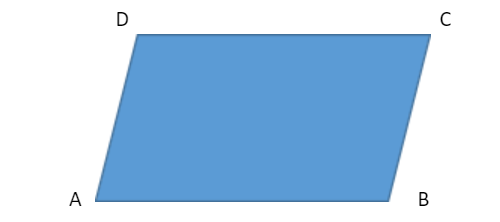
If the given points (1,2), (4,y), (x,6) and (3,5) are the vertices of a parallelogram taken in order. Find x and y.
Answer
605.1k+ views
Hint: First name the coordinates of all the vertices of the parallelogram. Find the coordinates of mid-points of the diagonal using the coordinates of the vertices. Since it’s a parallelogram, coordinates bisect each other, hence, equate both coordinates of midpoint obtained from two diagonals and then proceed.
Complete step-by-step answer:

Let A(1,2), B(4,y), C(x,6) and D(3,5) are the vertices of a parallelogram ABCD
AC and BD are the diagonals.
O is the mid-point of AC and BD
The coordinates of mid-point are given by \[\left[ {\dfrac{{{x_1} + {x_2}}}{2},\dfrac{{{y_1} + {y_2}}}{2}} \right]\]
If O is the mid - point of AC, then the coordinates of O are =\[\left( {\dfrac{{1 + x}}{2},\dfrac{{2 + 6}}{2}} \right) = \left( {\dfrac{{x + 1}}{2},4} \right)\]
If O is the mid-point of BD then coordinates of O are=\[\left( {\dfrac{{4 + 3}}{2},\dfrac{{5 + y}}{2}} \right) = \left( {\dfrac{7}{2},\dfrac{{5 + y}}{2}} \right)\]
Since both coordinates are of the same point O
∴ \[\dfrac{{1 + x}}{2} = \dfrac{7}{2}\]
\[ \Rightarrow 1 + x = 7\]
\[x = 7 - 1 = 6\]
∴\[\dfrac{{5 + y}}{2} = 4\]
\[ \Rightarrow 5 + y = 8\]
\[ \Rightarrow y = 8 - 5 = 3\]
Hence, x = 6 and y = 3.
Note: Following are the properties of Parallelogram are:
Opposite sides are parallel.
Opposite sides are congruent.
Opposite angles are congruent.
Consecutive angles are supplementary.
Diagonals intersect each other.
Complete step-by-step answer:

Let A(1,2), B(4,y), C(x,6) and D(3,5) are the vertices of a parallelogram ABCD
AC and BD are the diagonals.
O is the mid-point of AC and BD
The coordinates of mid-point are given by \[\left[ {\dfrac{{{x_1} + {x_2}}}{2},\dfrac{{{y_1} + {y_2}}}{2}} \right]\]
If O is the mid - point of AC, then the coordinates of O are =\[\left( {\dfrac{{1 + x}}{2},\dfrac{{2 + 6}}{2}} \right) = \left( {\dfrac{{x + 1}}{2},4} \right)\]
If O is the mid-point of BD then coordinates of O are=\[\left( {\dfrac{{4 + 3}}{2},\dfrac{{5 + y}}{2}} \right) = \left( {\dfrac{7}{2},\dfrac{{5 + y}}{2}} \right)\]
Since both coordinates are of the same point O
∴ \[\dfrac{{1 + x}}{2} = \dfrac{7}{2}\]
\[ \Rightarrow 1 + x = 7\]
\[x = 7 - 1 = 6\]
∴\[\dfrac{{5 + y}}{2} = 4\]
\[ \Rightarrow 5 + y = 8\]
\[ \Rightarrow y = 8 - 5 = 3\]
Hence, x = 6 and y = 3.
Note: Following are the properties of Parallelogram are:
Opposite sides are parallel.
Opposite sides are congruent.
Opposite angles are congruent.
Consecutive angles are supplementary.
Diagonals intersect each other.
Recently Updated Pages
Master Class 10 General Knowledge: Engaging Questions & Answers for Success

Master Class 10 Science: Engaging Questions & Answers for Success

Master Class 10 Social Science: Engaging Questions & Answers for Success

Master Class 10 Maths: Engaging Questions & Answers for Success

Master Class 10 English: Engaging Questions & Answers for Success

Master Class 10 Computer Science: Engaging Questions & Answers for Success

Trending doubts
Why is there a time difference of about 5 hours between class 10 social science CBSE

Write a letter to the principal requesting him to grant class 10 english CBSE

What is the median of the first 10 natural numbers class 10 maths CBSE

The Equation xxx + 2 is Satisfied when x is Equal to Class 10 Maths

Which of the following does not have a fundamental class 10 physics CBSE

State and prove converse of BPT Basic Proportionality class 10 maths CBSE




